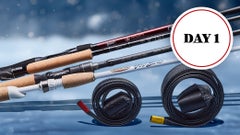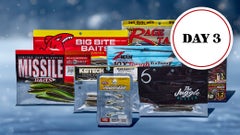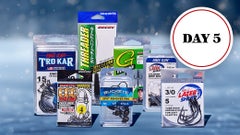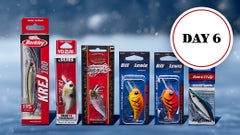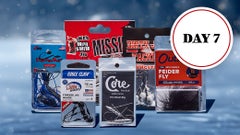Summer Deep Cranking Patterns & Techniques
There’s no more efficient way to find and trigger deeper schools and structure-oriented fish in the summer than with a Deep Diving Crankbait. Fish are aggressive and highly competitive this time of the year, and deep cranking is the perfect tool to ignite a school of bass and load the boat. Keep a wide selection of sizes and colors on board so that you can fine-tune your presentation to the mood of the fish.
Rods:
Long casts are critical to getting the crankbait to its desired depth, so most anglers prefer longer rods in the 7’6” to 8’ range with a graphite, composite, or glass blank. Moderate to moderate-fast tapers are also crucial for fishing crankbaits. Medium-heavy to heavy action cranking rods are a good place to start, but the action you’ll want will depend on the weight of your crank and the type of cover you are fishing around. A full handle is also a great idea because it allows you to tuck the rod comfortably under your arm during the retrieve.
Reels:
With long casts and deep depths being the norm, you want a reel in the 200-size range with plenty of line capacity, especially when throwing bigger cranks that get down to 20+ feet. When considering gear ratios, many anglers prefer slower gear ratios in the 5:1 range, but any moderately fast gear ratio in the 6:1 to 7:1 range will also do the trick.
Line:
Fluorocarbon line is usually the norm for fishing deep cranks. It sinks, is nearly invisible, and provides a little bit of stretch to absorb strikes. 12 to 20-lb test, depending on the size of the crankbait, is a good place to start. Lighter crankbaits will require a slightly smaller line or you’ll sacrifice casting distance, but generally, using the heaviest line you can cast a given crankbait is a good rule of thumb.
Modifications & Rigging:
Nowadays, most crankbaits on the market have pretty good hooks straight out of the package, but upgrading your treble hooks is never a bad idea — especially if you are fishing a tournament. A quick-change snap can help determine the pattern your bass are chasing without the need for constant re-ties. Suspend dots or strips can also be a great call to help entice lethargic fish to bite.
Tips & Tricks:
Bury the tip of your rod in the water as soon as you cast, so your line breaks the surface tension and starts to angle down. Don’t be afraid to kneel and reel either! A lot of bites come off of deflections, or times when your crankbait bounces off structure. Make sure to pause or throw slack in your line anytime you feel your crankbait bounce off any rock or structure, and hold on. Having a plug knocker on board is also a great idea to help save some money and free your crankbait from snags. Have a rattling and a silent crankbait rigged up at all times; switching sounds after a bite window ends can often re-ignite the school and help you put more fish in the boat.
Colors:
Shad patterns or even Bluegill patterns work well in the summer, but with deep cranking, you often want something that stands out. Brighter colors like Chartreuse Blue or Citrus Shad work very well, as do Craw patterns, like Chili Bowl or Red Craw. Make sure to bring a few options for different water clarities. More natural or translucent patterns are usually better in clearer water conditions, while brighter White or Chartreuse options are better suited for stained waters. Colors are something you’ll need to play around with to see what works in your waters.
















































